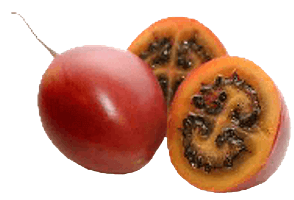What is Tamarillo?

Overview:
Sintific name:(Cyphomandra betacea)
Tamarillo is a small shrub flowering plant of the nightshade family (Solanaceae). It is an egg-shaped edible fruit about 4-10 cm long. Tamarillo fruit colors range from yellow and orange to red and almost purple. Red Tamarillo fruits are more sour, yellow and orange fruits are sweeter. The fruit is Before 1967 was known as ” Tree Tomato” but new renamed Tamarillo. Tamamoro is also known in South America as Terong Belanda (Dutch eggplant) known in Indonesia. It is very popular worldwide, especially in Peru, Colombia, New Zealand, Ecuador, Rwanda, Australia and the United States.
It is native in Ecuador, Colombia, Peru, Chile, Argentina and Bolivia. Yet it is one of the most popular fruits in the local area and is cultivated in gardens and small gardens for production. It is also cultivated in other parts of the world. Such as Kenya, Rwanda, South Africa, Nagaland, India, Nepal, Hong Kong, China, the United States, Australia, Bhutan and New Zealand.
The Nutritional value of Tamarillo
Water: ( 81-87 ) g
Proteins : (1.5-2.5) g
Fat : (0.05-1.28) g
Fiber: (1.4-6.0) g
Acidity: (1.0-2.4) g
Vitamin-C: (0.32-1.48) mg
Vitamin-A: (19.7-57.8) mg
Calcium: (3.9-11.3) mg
Magnesium: (19.7-22.3) mg
Iron: (0.4-0.94) mg
Tamarillo Health benefits
Healthy heart:
Potassium, a nutrient that is abundant in tamarillo, helps balance the harmful effects of sodium levels on the heart. It provides magnesium for the proper functioning of the cardiovascular system. Also, It contains high fiber ingredients that help the body regulate the absorption of bad cholesterol.
Weight lose:
Tamarillo is very beneficial for those people who want to lose weight. It acts as a detoxifier when eaten raw, in the form of salads or as a tamarind juice. Its acidic properties help reduce fat.
Healthy Skin:
Tamarillo provides vitamins A and C to keep your skin healthy and radiant. Anthocyanins, phenols and flavonoids protect the skin from oxidative stress and pollution. It also helps prevent skin aging.
Blood sugar levels:
Tamarillo has very few calories. Chlorogenic acid found in tamarillo can help lower blood sugar levels in type-2 diabetes. Tamarillo holds great antioxidants that can reduce oxidative stress in organs such as the pancreas and liver.
Prevent Cancer:
Tamarillo contains powerful antioxidants that help fight cancer-causing free radicals. It has anti-microbial and anti-inflammatory properties that help stop the growth of cancer.
Vision:
Tamarillo contains vitamin A which is a very good fruit for maintaining healthy eyesight. Vitamin A restores moisture in the membranes of the eyes which acts as a barrier to bacteria and viruses in the eyes. It protects the eye from infection and protects against damage to eye diseases such as cataracts and macular degeneration.
How to Grow tamarillo from seed in the pot?
Tamarillo seeds are sown from spring to autumn. When sowing seeds in spring, a heating pad should be used for seed germination at temperatures About 78 º F (25.5ºC). This is because the seeds need warm temperatures to germinate. If tamarillo is sown in autumn, so, warm temperatures are not necessary.
Sprinkle the seeds into a pan filled with a little seed-picking mixture and lightly cover. Watering should be done regularly as dryness can hinder germination. Let the seedlings grow like this for a while. When the seedlings are slightly larger, it is time to take out the seedlings and transfer them to individual pots. When doing this, care should be taken so that the roots of the tree are not disturbed too much. Continue to water your plants regularly.
The trees grow up to 5 meters Fruit production from 4 years in full swing and its lifespan is about 12 years. The leaves are large, simple and perennial, and have a pungent odor. The flowers are pinkish-white and form 10 to 50 clusters of flowers. They give 1 to 6 fruits per cluster.
Propagation is possible by either Tamarillo seeds or cuttings. The seedlings first grow straight before leaving the branches, forming stems about 1.5 to 1.8 m long. Propagation by seeds is easy and safe.The tree grows very fast and is able to bear fruit after 1.5 to 2 years. The fruits do not ripen at the same time. A single tree can bear more than 20 kg of fruit per year.